Tapping into Talent Mobility: Accelerating your Strategy
Understand why internal mobility needs to be part of your recruitment strategy and where redeployment plays a role.
Hear success stories on getting internal mobility programs off the ground and achieving great results.
Get to know how to leverage external recruitment spend for redeployment and internal mobility initiatives.



Internal talent mobility is the trend to emerge during the pandemic that nobody really saw coming. But massive global changes to, well, everything have driven real business needs to redeploy and reskill people to new roles and functions to meet demand and ensure organizations can pivot and survive.
And with employers spending up to $40 billion on recruitment every year, according to SmartRecruiters stats, the stakes couldn’t be higher in an extremely crucial area. To shine a light on how to get it right, Kate Graham, Head of Content Labs and Insights at UNLEASH is joined by Fran Pestana, Global Talent Management and Inclusion Lead at E.ON SE, and Allyn Bailey, Executive Director of Hiring Success at SmartRecruiters as they talk about the role of HR, technology, and how to shift to a new, truly expansive and inclusive model of skills and recruiting.
People build a new marketplace skill for a company at a minimum of once every two-to-three months.
Allyn Bailey, Executive Director of Hiring Success at Smart Recruiters
Watch on-demand to:
- Hear about how a focus on internal mobility can underpin business adaptability, flexibility, and survival.
- Discover how technology plays a role in a more holistic and strategic approach to talent and recruitment.
- Understand how to properly reconceive your talent and why dynamism is the new state of play.
The evolution of internal talent mobility
For many in HR, internal talent mobility might still be a buzz phrase they’ve read or heard about over the last couple of years. And that’s fine: traditionally talent searches focus on the external. However, the pandemic appears to have changed all of this. That is, according to Fran Pestana. As she sees it, talent searches have become less rigid and more flexible and agile, with employees having more personalized and less rigid career paths set out for them i.e. incumbent employees now have greater opportunity to access opportunities that previously might not have been available for them. Although this is being led by organizations, it also helps them move – and this is also incredibly useful from a branding and wellbeing perspective, too – from being business-focussed primarily to being more human-focussed, too. Yet, as Pestana warned, this shouldn’t be done in a purposeless manner: the end goal is, within a distributed workforce model, to optimize both external and internal talent in order to serve the needs of the business on a transformational landscape. That’s internal mobility that works!
Of course, this is a challenge and requires a reconceptualizing of the talent lifecycle. There will be questions, as Bailey laid out, around who owns talent as it progresses through the organization and who is responsible for an individual’s career path – a question that is increasingly important when that career path might go in unexpected ways. There, of course, will also be questions regards how managers can have their talent needs to be met – crucial as more employees start to make lateral or lattice moves – and how to eliminate the tension between those who are now looking internally to satisfy an appetite for talent that once was externally focussed, and those with specific in-house needs. Simply put, although most see the evolution of internal talent mobility as a good thing, it does require careful management.
What does internal talent mobility look like in practice?
For Pestana, one of the biggest changes that internal talent mobility will bring about is around how talent is conceptualized. In her view, an internal mobility approach to talent management should better align diversity, mobility, opportunity et al. in a more holistic model. In addition, it should make teams more multi-disciplinary, which will further work to break down barriers and should work to further the inclusivity and personal empowerment agendas within organizations. This should then work to allow individuals more autonomy over their career paths.
Of course, this will then present further challenges for HR in how it enables this type of environment and then steers it. Culture, mindsets, siloes, talent hoarding; this will all need to be challenged! Here, the people function might consider where technology plays a role, especially as they have to sell internal mobility to managers as a way that can open up potential talent to them, rather than getting them solely focused on the risk of losing their best talent and disrupting their teams.
HR’s role will also have to be a supportive one as they work on messaging and modeling to show leaders and managers, and even talent itself, the benefits and ways internal mobility can have. They will have to think about new ways of selecting and assessing talent and start to move towards a skills-based approach, which could further change how their organization perceives roles for the future.
Crucially, they will also have to think about how to create opportunities for employees to develop into new roles and how to make internal mobility more accessible to the incumbent workforce. Presently, many organizations focus on external to the detriment of internal opportunity and that must be re-balanced. And, with so much change going on, there will have to be careful consideration of the management of the process as organizations head towards being more internally mobile. Although it should seek, eventually, to give employees more autonomy in their careers, to keep the process on track it will require top-down management, something Bailey noted, which could produce tension along the way.
New ways of thinking about talent and recruiting
In the webinar, Bailey also explained that with so much change around the talent agenda, there should be further evolution in how organizations view their talent. For businesses that go on this journey, they will begin to reframe what they think ‘good’ talent looks like: moving from an experience/seniority assessment assessment to skills and potential playing a more leading role. They will also have to think about moving from a static view of talent – one where the total skills an individual is perceived to have exactly align with the role they were hired to do – to a model where it is better understood how dynamic talent is, and how individuals are constantly gaining new skills. If businesses do this well, they are more open to accessing the benefits incumbent within.
However, as Pestana emphasized, this can only happen if companies are less rigid about their recruiting strategies. Instead of being hamstrung by stringent rules that can forestall sourcing teams from truly being expansive in their searches, they should allow more freedom to these teams. Here, technology can enable good practice. By focussing on using technology that allows different platforms and enhancements to integrate, that allows users to self-report their skills, interests, and development, and aligns to learning journeys to customer and market needs, HR can help inform role creation and evolution. This can give HR and recruiting teams the analysis and helicopter view of the business in real-time – something increasingly important as the talent landscape becomes more dynamic, changeable, and uncertain.
Watch On Demand
"*" indicates required fields
Contact Us
"*" indicates required fields
Partner with UNLEASH
"*" indicates required fields
